Al Nabawi Mosque rises majestically from the heart of Madinah, an architectural testament to Islamic heritage dating back over 1,400 years to 622 CE. This revered sanctuary holds profound religious significance as Islam's second-holiest site while simultaneously claiming status as the world's second-largest mosque. The sprawling complex spans an impressive 1.7 million square feet, welcoming between 1 and 2 million faithful worshippers within its sacred walls.
Visitors stepping onto these hallowed grounds walk where Prophet Muhammad himself once labored, personally establishing the original structure known alternatively as Masjid an-Nabawi. Ten magnificent minarets punctuate the skyline, the tallest soaring 105 meters heavenward. The mosque's iconic Green Dome, constructed in 1817, stands as perhaps its most recognizable feature, while 250 ingeniously designed retractable umbrellas provide essential shade across 143,000 square meters of courtyard space. Throughout centuries, Masjid al Nabawi has witnessed countless expansions and renovations, most recently undergoing enhancements valued at approximately $18.6 billion.
This exploration delves into the remarkable elements distinguishing this spiritual landmark from all others. Readers will journey through its most sacred spaces, including the revered tomb of the Prophet, examine modern facilities enhancing visitor comfort, learn precise prayer schedules, and gather valuable insights for maximizing their pilgrimage to this perpetually operational sanctuary in Saudi Arabia.
The sacred structure of Masjid al Nabawi transcends ordinary architectural achievements, embodying spiritual dimensions that resonate deeply with Muslims worldwide through distinctive elements of sanctity and historical significance.
Masjid al-Nabawi occupies the revered position as the second-holiest site in Islam after Masjid al-Haram in Mecca. This exalted status draws countless pilgrims performing Hajj and Umrah, seeking spiritual fulfillment within its hallowed walls. The Prophet's Mosque stands as the second largest mosque not merely in Saudi Arabia but across the entire world, capable of welcoming more than 3.2 million worshippers simultaneously during peak gatherings. Muslim tradition attributes extraordinary spiritual merit to prayers offered here—a single prayer performed at Masjid al-Nabawi equals the blessing of 1,000 prayers conducted elsewhere, with the sole exception being prayers at Masjid al-Haram.
The mosque's genesis traces to 622 CE, following Prophet Muhammad's momentous migration (Hijra) from Mecca to Medina. Historical accounts reveal the Prophet's direct involvement in construction, personally overseeing building efforts while emphasizing simplicity and modesty throughout the project. Two orphaned children, Sahl and Suhayl, originally owned the land and offered it freely, yet the Prophet insisted upon proper payment. Abu Ayyub al-Ansari ultimately provided the necessary funds, becoming the mosque's first benefactor. Construction spanned seven months, culminating in a modest structure measuring approximately 30 by 35 meters in its original form.
Masjid al-Nabawi served purposes far beyond worship, functioning as the heartbeat of early Islamic society. The original open-air building simultaneously operated as a community center, judicial court, and educational institution. From this sacred space, the nascent Muslim community established governance, political deliberations unfolded, foreign delegations received an official welcome, and strategic military planning took place within its boundaries. Economic vitality blossomed around the mosque grounds, establishing it as the undisputed center of Medinan daily life.
Several sacred areas enhance the mosque's spiritual gravity. The Rawdah (Riyad ul-Jannah) holds particular reverence as one of the "Gardens of Paradise" mentioned in Islamic tradition. Beneath the mosque's distinctive Green Dome lies the final resting place of Prophet Muhammad himself, alongside his beloved companions Abu Bakr and Umar. Through fourteen centuries of expansions and reconstructions, Masjid al Nabawi remarkably preserves its essential spiritual character while evolving physically to welcome millions of pilgrims who journey to experience its sanctity.
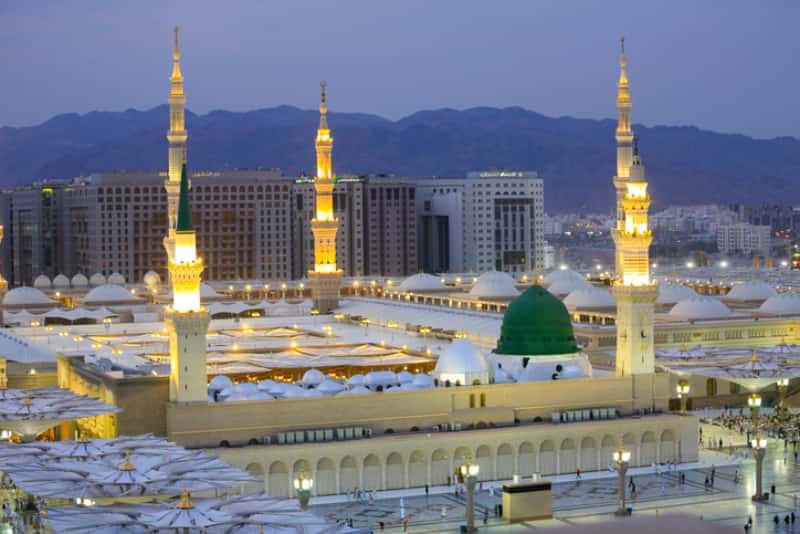
The interior of Al Nabawi Mosque unfolds as a tapestry of hallowed chambers and sanctified areas, each bearing witness to centuries of reverence and devotion. These sacred spaces form the spiritual nucleus of a structure whose walls have absorbed countless prayers since the earliest days of Islam.
Nestled within Masjid an-Nabawi's central expanse lies the venerated Rawdah, a rectangular sanctuary stretching from Prophet Muhammad's tomb to his original pulpit position. This extraordinary space derives its exalted status from the Prophet's own declaration: "The area between my house and my minbar is one of the gardens of Paradise." Pilgrims instantly recognize this hallowed ground by its distinctive green carpeting, which stands in striking contrast to the mosque's predominant red floor coverings. Measuring precisely 22 meters in length and 15 meters in width, the Rawdah encompasses a modest 397.5 square meters—a space proportionally small yet spiritually immense. Faithful Muslims cherish this area above almost all others, holding firm to the belief that supplications offered here possess a divine guarantee against rejection.
The southeastern quadrant of Masjid al Nabawi cradles humanity's most precious human remains—the final resting place of Prophet Muhammad himself, alongside his beloved companions Abu Bakr and Umar. Crowning this sacred burial chamber stands the mosque's most recognizable feature, the magnificent Green Dome. This architectural marvel began its existence humbly as an unadorned wooden cupola in 1279 CE. The dome's appearance transformed through centuries—adorned with blue and silver pigments during the late 15th century, completely reconstructed in 1817 under Ottoman Sultan Mahmud II's directive, and finally cloaked in its characteristic emerald hue in 1837 CE. Fascinatingly, a fourth burial space remains vacant beside these revered graves, reserved for Prophet Isa (Jesus)—a physical manifestation of the Islamic prophecy foretelling his eventual return.
The Ottoman Prayer Hall represents the oldest architectural jewel preserved within today's expanded mosque complex, dating back to Sultan Abdulmajid I's ambitious reconstruction during the 1840s. This historical treasure showcases approximately 170 domes of varying dimensions, with the Green Dome commanding prominence among them. Engineering ingenuity manifests in the southern section's 27 sliding domes, designed to create natural light wells that illuminate the prayer space below. Particularly notable is the hall's artistic heritage—master craftsmen who adorned this space maintained ritual purity throughout their labors, continuously reciting Qur'anic verses as their hands shaped intricate decorative elements. Modern visitors traversing this section forge a direct connection with Ottoman architectural brilliance and Islamic artistic tradition.
The mosque's intellectual treasure house, established in 1352 AH (approximately 1933 CE), safeguards some of Islam's most precious literary artifacts. This remarkable repository houses 250 ancient Qur'anic manuscripts, 4,052 handwritten texts, 4,600 illustrated manuscripts, and an extensive digital collection exceeding 260,000 documents. Particularly noteworthy among these treasures are rare endowment deeds dating to 1184 CE. Welcoming roughly 110,000 knowledge-seekers annually, the library accommodates diverse scholarly needs through dedicated reading spaces for men, women, and children, alongside specialized departments devoted to audio recordings, manuscript preservation, and digital archiving. Here, Islam's intellectual heritage finds protection and purpose, continuing its centuries-old mission of enlightenment.
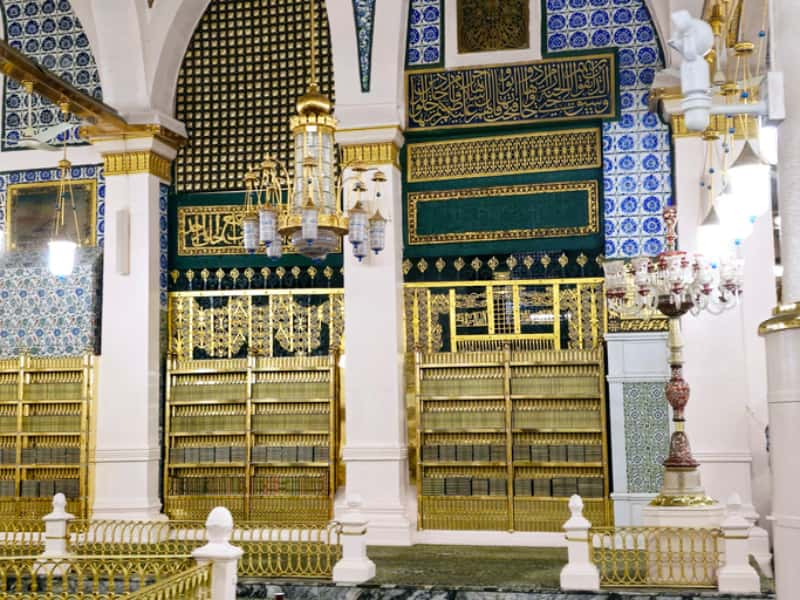
The mosque houses a collection of historical mihrabs (prayer niches), each bearing unique historical significance. Mihrab Nabawi identifies the Prophet's original prayer position, while the more expansive Mihrab Uthmani serves contemporary congregational needs. Other notable prayer niches include Mihrab Fatimah, Mihrab Suleimani, and Mihrab Tahajjud. The Prophet's original wooden pulpit (minbar) has undergone several replacements throughout history, with the current marble masterpiece dating to Ottoman Sultan Murad III's commission in 1590.
Ten towering minarets, each reaching 104 meters skyward, now grace the mosque's perimeter. These architectural sentinels feature an elegant five-tiered design that transitions gracefully from square bases to octagonal midsections before culminating in cylindrical apexes. Equally impressive, 27 sliding domes mounted on square foundations illuminate the prayer hall below through ingeniously placed apertures at their bases.
The mosque's 27 sliding domes, installed in 1992, represent a masterpiece of sacred engineering—capable of opening completely within a mere sixty seconds to provide natural ventilation. These Moroccan-inspired creations blend modern aircraft-grade composites with exquisite hand-carved cedar embellishments. Complementing this innovation, 250 retractable umbrellas unfurl across the courtyard, sheltering 143,000 square meters and forming a continuous protective canopy for worshippers regardless of weather conditions.
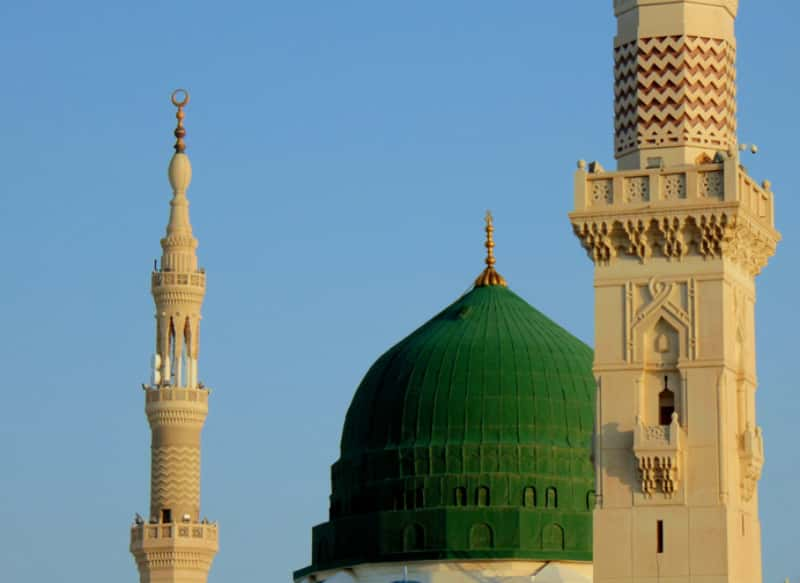
Al Nabawi Mosque harmoniously blends centuries-old spirituality with remarkable technological innovations, creating an environment where millions of annual pilgrims worship in comfort regardless of Madinah's challenging climate.
The mosque's exterior showcases 250 convertible umbrellas stretched across 143,000 square meters, offering vital protection from Madinah's scorching sunlight and periodic rainfall. These architectural marvels employ sophisticated folding arm mechanisms featuring six precision-engineered hinges, strategically positioned at varying heights to form a seamless protective canopy. Their PTFE fabric construction delivers superior UV radiation shielding while maintaining self-cleaning properties and exceptional durability.
Within the mosque walls, worshippers experience climate perfection thanks to what experts recognize as the world's largest single-building cooling system. The central cooling station stands seven kilometers from the mosque premises, occupying a vast 70,000 square meters. Six industrial-grade chillers operate continuously, each generating 3,400 tons of cooling capacity. This technological masterpiece maintains ideal temperatures between 21-24°C throughout the year, circulating chilled water through an extensive network of 151 specialized air treatment units. Supplementing this system, 436 strategically positioned misting fans provide additional cooling throughout the open courtyard areas.
Mosque authorities demonstrate exceptional commitment to inclusivity through specialized teams dedicated to assisting elderly and mobility-challenged visitors. Thoughtfully designed ramps provide wheelchair access at all primary entrances, while dedicated staff members manage wheelchair availability and distribution. The expansive complex accommodates more than one million simultaneous worshippers, offering both sheltered indoor halls and open-air prayer spaces.
Precise prayer schedules govern daily worship at Masjid al-Nabawi. The current timetable (May 17, 2025) establishes Fajr at 4:10 AM, Dhuhr at 12:18 PM, Asr at 3:43 PM, Maghrib at 6:59 PM, and Isha at 8:29 PM. Visitors must adhere to established protocols, including appropriately modest attire covering arms and legs, removal of footwear before traversing carpeted areas, maintaining quiet reverence, and refraining from disruptive flash photography.
Female worshippers enter through designated gates 21-25 and 28-30, with gate 37 providing the closest proximity to Rawdah. Recent policy changes have expanded access, granting women permit-free entry to the courtyard following Fajr and Isha prayers via doors 21 and 32.
Pilgrims seeking to experience Rawdah must secure advance authorization through the Nusuk application following these steps:
Women may visit Rawdah from 6:00 AM-11:00 AM and 9:30 PM-12:00 AM Saturday through Thursday, with Friday schedules featuring slight modifications.
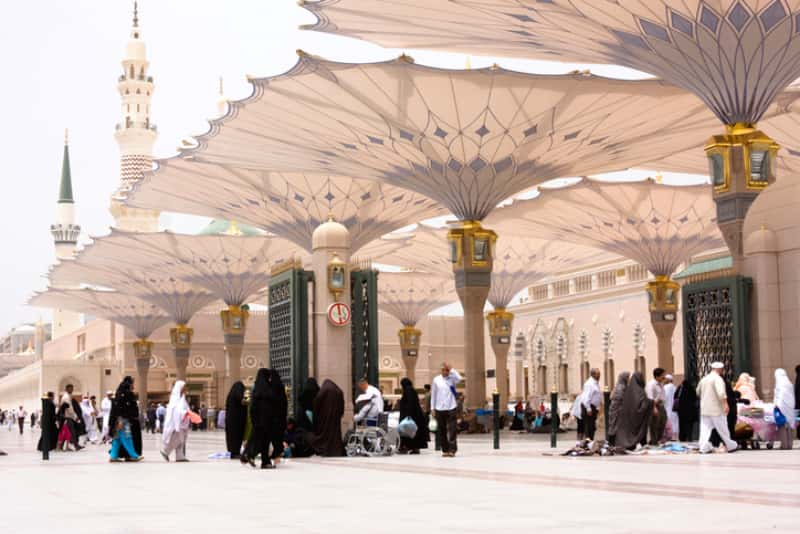
Pilgrimage to Al Nabawi Mosque demands thoughtful planning and strategic timing to fully embrace its spiritual dimensions. Careful preparation yields the most profound experiences within these hallowed walls.
Seasoned travelers recommend November through February as the prime visiting period, when Madinah bathes in pleasant temperatures ranging from 18°C to 30°C. The tranquil moments following Fajr prayers and the peaceful hours after Isha offer remarkable serenity amid noticeably thinner crowds. Ramadan undoubtedly infuses the atmosphere with extraordinary spiritual vibrancy, though pilgrims should anticipate substantially larger gatherings and premium accommodation rates during this sacred month. Those contemplating visits during Eid al-Fitr or Eid al-Adha must secure lodgings several months beforehand to avoid disappointment.
Jannat al-Baqi, Madinah's oldest Islamic cemetery, cradles approximately 10,000 companions of the Prophet Muhammad in eternal rest. Situated southeast of Al Nabawi Mosque, the cemetery welcomes visitors twice daily—following Fajr and Asr prayers—though female pilgrims may only observe from surrounding roadways.
Four kilometers distant stands Masjid Quba, recognized as Islam's first mosque. Devotees often trace the Prophet's footsteps along Quba Walkway, a journey requiring approximately 45 minutes. Islamic tradition teaches that offering two rakats of prayer at Quba bestows rewards equivalent to completing Umrah.
Paramount among visitor obligations remains dignified conduct throughout the mosque premises. Conversations near the Prophet's tomb should proceed in hushed tones, while physical contact with fellow worshippers, particularly in densely populated areas, warrants special caution. Photography utilizing flash remains strictly prohibited. Male visitors should don clean, modest attire, while women must ensure their hair and physique remain covered beneath loose-fitting garments. Footwear must be removed before treading upon carpeted sections, and personal belongings should remain under vigilant supervision.
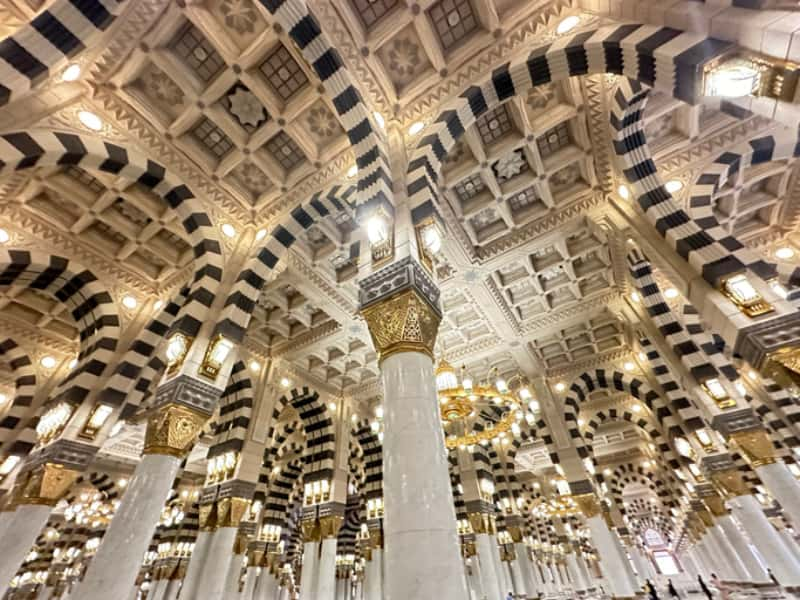
Al Nabawi Mosque stands majestically as the living embodiment of Islamic heritage and spirituality. From its humble beginnings 1,400 years ago—a modest structure erected by Prophet Muhammad's own hands—this sacred site has flourished into the world's second largest mosque without diminishing its profound religious significance.
Pilgrims quickly discover that Masjid al-Nabawi transcends mere architectural splendor. The spiritual resonance of standing within Rawdah's blessed confines, gazing upon the iconic Green Dome, wandering through the historic Ottoman Prayer Hall, or marveling at ancient manuscripts creates an indelible imprint upon the soul. Thoughtful modern additions—the ingenious retractable umbrellas and sophisticated climate control systems—ensure physical comfort regardless of seasonal timing.
Meticulous preparation fundamentally enhances the pilgrimage experience. Acquiring necessary permits via the Nusuk application, selecting moderate weather months for visitation, and familiarizing oneself with prayer schedules allows devotees to immerse themselves fully in worship rather than grappling with logistical concerns. Proper etiquette knowledge similarly demonstrates reverence for this hallowed ground where millions congregate annually to connect with their spiritual heritage.
Masjid al Nabawi represents far more than a destination marked on maps—it constitutes living history where prayers carry extraordinary weight and every corridor whispers stories of unwavering faith. Whether visitors seek solitary contemplation or join the magnificent congregation beneath soaring minarets, the Prophet's Mosque provides an unparalleled connection to Islamic tradition. This sacred sanctuary continues its centuries-old mission: welcoming, inspiring, and spiritually nourishing pilgrims from every corner of our globe.
FAQs
Q1. What is the proper etiquette when entering Al Nabawi Mosque?
When entering Al Nabawi Mosque, it's customary to step in with your right foot first while reciting a supplication. Dress modestly, speak softly, and maintain a respectful demeanor throughout your visit. Remove your shoes before stepping onto carpeted areas and avoid taking flash photographs, especially near the Prophet's tomb.
Q2. What should I do upon first entering Masjid al-Nabawi?
Upon entering Masjid al-Nabawi, it's recommended to offer a two-rakat prayer known as Tahiyyatul Masjid. After this, you may join the queue for Ziyarah if you wish to visit the Prophet's tomb. Remember to maintain a calm and reverent atmosphere, respecting fellow worshippers and the sanctity of the space.
Q3. Is the dome of Masjid al-Nabawi made of real gold?
The iconic Green Dome of Masjid al-Nabawi is not made of solid gold. It's constructed of 24-karat gold-plated stainless steel. This current design was implemented during the reign of King Fahad bin Abdul Aziz, replacing the previous silver dome from 1916.
Q4. How many worshippers can Al Nabawi Mosque accommodate?
Al Nabawi Mosque has an impressive capacity, able to accommodate over 1 million worshippers simultaneously. The mosque spans approximately 1.7 million square feet, making it the second largest mosque in the world. This vast space allows for a significant number of pilgrims to pray together, especially during peak times like Ramadan.
Q5. How can I visit the Rawdah area in Masjid al-Nabawi?
To visit the Rawdah (Riyad ul-Jannah) area in Masjid al-Nabawi, you need to obtain a permit through the Nusuk app. Select "Prophet's Mosque Services" and then "Praying in Noble Rawdah" to choose an available time slot. Arrive at least an hour before your appointment due to queues. Men should enter through gate 39, while women use gate 37 for entry and gate 38 for exit.
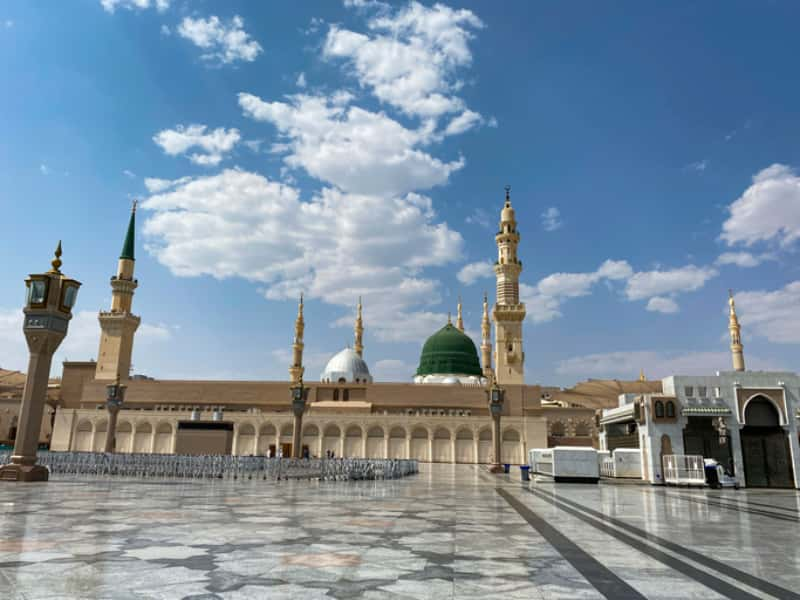
Find Related Tours


© Copyright 2024 Go Saudi Arabia Trips. All Rights Reserved.